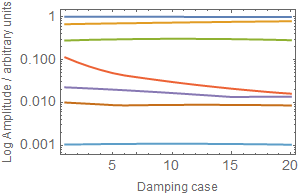The pat wain is a drum circle, consisting of normally 21 drums which is unique in the world. The drums can be tuned and therefore melodies can be played on it. This is astonishing as drums are percussion instruments with no clear pitch. Therefore the player tunes the instruments in a way the pitch character of the sound is enhanced such, that a clear pitch appears.
Here is a performance of a performance of Kyaw Zay, a virtuous pat wain player from Myitkyina, Myanmar:
More videos on Collection Bader.
The drums are tuned adding a paste to the drum head:
But this paste does not only tune the pitch of the isntrument, it also changes the relations of its overtones. Using a Finite-Difference Model (FDM) of the drum with a viscoelastic damping model the effect of the added paste is simulated. Below is a figure which shows how the different mode of vibration (each row is one frequency) changes when adding more and more paste to the drum head (left column is without past, right is completely covered, in between is more and more coverage in a circle with growing radius):


Then the frequencies of the drum change realtive one to another. Below is a figure showing the frequencies of the first eight partials in relation to the fundamental frequency:

Indeed the relation of two partials close to 2:1 (octave) and 3:1 (duodecime) are getting closer to the perfect values of 2:1 and 3:1 respectively. Here are the measured relations for all drums of the loud first three partials:

The added viscoelastic damping of the membrane changes amplitudes of some overtones a bit:

But not the frequencies:

Therefore the instrument is made tunable by basically tuning the second and third partial towards the relations 2:1 (octave) and 3:1 duodecime. The higher partials are low in volume and therefore do not disturb the harmonic spectrum achieved by the added paste.
Interesting is also the tuning of the drum. Below are the deviations of the real tuned instruments to Western just intonation (blue) and an equidistant 7-tone scale (red). Both do not fit, but the tuning follows a pattern also found with the Roneat deik in Cambodia and is similar to tunings of Balinese gamelans, namely that there are a few intervals too short followed by many too large. Maybe this is a tuning much in favour today in Southeat Asian countries:

Lit.:
Bader, R.: Finite-Difference model of mode shape changes of the Myanmar pat wain drum circle using tuning paste. Proc. Mtgs. Acoust. 29, 035004 (2016); doi: 10.1121/2.0000450
